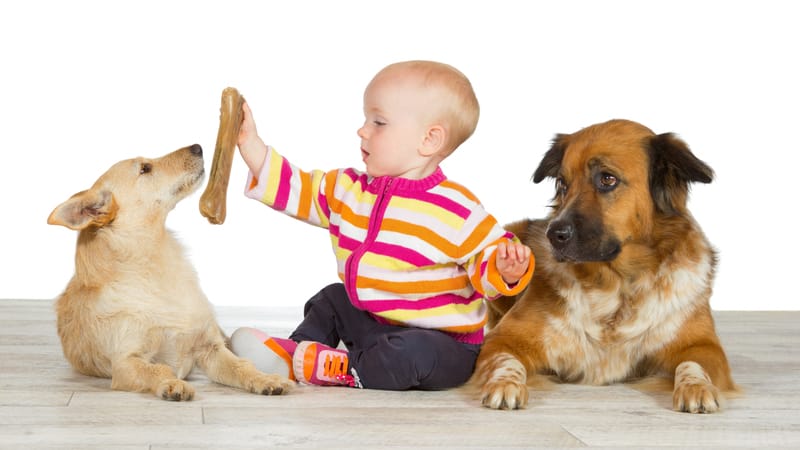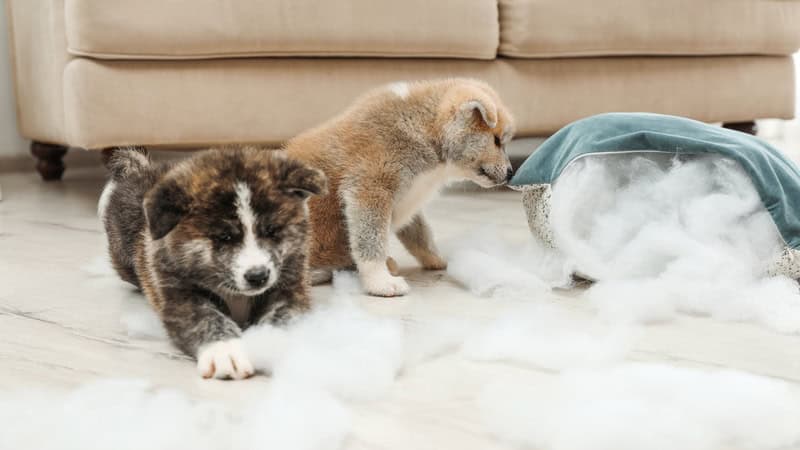My Pet World: Introducing Dogs to a New Baby ... And Cats to a New Boyfriend
The stakes are high when pets have trouble adapting to change

Pet expert Cathy L Rosenthal offers advice for introducing dogs to a new baby and helping a wary cat accept a new boyfriend.
Dear Cathy: My daughter and her wife are expecting a baby in November. They have two dogs – a small bichon-Yorkie mix and a large husky-greyhound mix. The Yorkie, Shelbie, is the older dog. She is protective of my daughter and will growl sometimes if children approach her too quickly. Llama, the younger larger dog, is not aware of her size and loves to greet people by nudging them with her nose and huge paws. How can they acclimate the dogs to this new human that will be entering their lives?
– Marsha, Queens, New York
Dear Marsha: While each dog will react differently to the arrival of a new baby, they also can cope with change – as long as it’s gradual. Have your daughter and her wife begin working on basic obedience training with the dogs, specifically sit, stay, down, here, and leave it. “Leave it” can apply to anything from a toy on the ground to a baby in a stroller. A well-mannered pet will be easier to manage around a baby.
Decorate the baby’s nursery in advance so the dogs can adjust to the new sights and smells.
Take the dogs for walks near playgrounds or invite friends with kids over so they get used to being around children.
If the pets’ routine will change, change it before the baby is born. If you normally walk your dogs at 7 a.m. but want to walk them at noon instead, begin the change now so they have time to adjust.
After your grandbaby is born, have someone bring home a blanket with the baby’s smell on it for the dogs to sniff so scent swapping can begin.
When the dogs see the baby for the first time, ask them to sit and give them treats while they observe the baby. Do not hold the baby out for them to meet. Give them treats whenever they are behaving well around the baby.
Give the dogs lots of attention when the baby is present so they associate this increased attention with the baby. Speak to the dogs as you feed the baby or change the baby’s diapers. Do this for a few weeks or months so they learn to like having the baby around.
As for Shelbie, she should never be in between your daughter and the baby. This is a protective position that feeds her need to protect your daughter. Either move Shelbie from this position or have your daughter step in front over her so Shelbie learns that she doesn’t need to be protective of your daughter.
Regardless of a dog’s temperament, dogs should never be left unsupervised with a baby. This basic rule of thumb will protect your baby from an excited pet and your pet from a wound-up child.
New boyfriend says of his girlfriend’s dog:
“I love spending time with my girlfriend but between being barked at, the dog in bed, and having to listen to him lick her face for three minutes straight, I am very put off.”
 Dear Cathy: My girlfriend has three cats – a 7-year-old female and a pair of 2-year-old Ragdoll cats, a male and a female. The older female and I get along fine and the rag doll female is a little more reticent but is becoming more accepting.
Dear Cathy: My girlfriend has three cats – a 7-year-old female and a pair of 2-year-old Ragdoll cats, a male and a female. The older female and I get along fine and the rag doll female is a little more reticent but is becoming more accepting.
However, Jax, the male, is quite hostile. He hisses and bares his teeth at me and seems resentful. He also displays this behavior toward my girlfriend’s ex-husband. I don’t push myself on pets just because they are cute. However, I would like to have a more amiable relationship with Jax. Any tips?
– Mike, Newington, Connecticut
Dear Mike: Sounds like Jax is not fond of men. I don’t know how long you dated your girlfriend, but it does take time for some cats to adjust to new people. Some cats are friendly right away, while others may be terrified and take months to adjust to your encroachment on their territory.
Either way, your approach is perfect. Wait for Jax to come to you. Buy some feline pheromones and spray your legs, pants, and lap whenever you’re around him. The pheromones will have a calming effect on him, and we want him to associate that feeling with you.
Next, talk sweetly to him. Cats react very positively to soft-spoken, kind voices. Have a conversation with him and say his name a lot.
Finally, play with him for five minutes every time you see him. Play is a great way to bond with a pet. Shine a laser pointer on the floor for him to chase or buy some lure-type cat toy – anything you can wiggle, dangle, or drag across the floor. If you do all this and are patient, he should eventually stop hissing at you.
Cathy M. Rosenthal is a longtime animal advocate, author, columnist, and pet expert who has more than 25 years in the animal welfare field. Send your pet questions, stories, and tips to cathy@petpundit.com. Please include your name, city, and state. You can follow her @cathymrosenthal.
© Tribune Content Agency, LLC.



